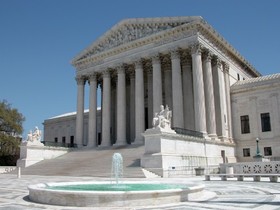This, a post by Marty Lederman, nails the inherent contradiction in the two Free Speech cases handed down yesterday by the Supreme Court:
A friend writes to note the striking contrast in the way the Chief Justice views the "reasonable" interpretation of the ambiguous expression in today’s two Free Speech Clause cases:
From Wisconsin Right to Life: “Because WRTL’s ads may reasonably be interpreted as something other than an appeal to vote for or against a specific candidate, they are not the functional equivalent of express advocacy,” the Chief wrote. In defining what qualifies as “express advocacy,” "the court should give the benefit of the doubt to speech, not censorship."
From Morse: : ”The message on Frederick’s banner is cryptic. But Principal Morse thought the banner would be interpreted by those viewing it as promoting illegal drug use, and that interpretation is plainly a reasonable one.”
There’s simply no way to reconcile this, in my view. I happen to believe that the conservative judges simply voted the outcome they wanted, rather than apply coherent and consistent legal rules. They liked the Right to Life message, so the Wisconsin Right To Life people win. They didn’t like Frederick’s "Bong Hits For Jesus" banner, so Fredericks loses.
Prof. Volokh is very big on free speech issues, especially when it comes to schools and students. He, too, sees a problem with Morse
Justice Alito, joined by Justice Kennedy, joined the majority opinion but only
on the understanding that (a) it goes no further than to hold that a public school may restrict speech that a reasonable observer would interpret as advocating illegal drug use and (b) it provides no support for any restriction of speech that can plausibly be interpreted as commenting on any political or social issue, including speech on issues such as the wisdom of the war on drugs or of legalizing marijuana for medicinal use.
…But what does this purported distinction between the speech in clause (a) (restrictable) and the speech in clause (b) (not restrictable) really mean? The trouble is that "speech that a reasonable observer would interpret as advocating illegal drug use" often also "can plausibly be interpreted as commenting on any political or social issue."
…So I think that this distinction is logically unsound, even in this very case. And this unsoundness also makes it hard to see how the distinction will play out in the future. For instance, say that a school argues in favor of restricting anti-gay speech on the grounds that it poses a threat to gay students’ "physical safety" by contributing to a culture in which gay-bashing is encouraged and gays are made to feel insecure. (Justice Alito’s opinion stresses that the new exception for pro-drug speech is justified by the fact that such speech jeopardizes students’ "physical safety," presumably through its persuasive effects.) And say a student wears a T-shirt saying "straight pride," or "homosexuality is an abomination."
Is this a "comment[] on any political or social issue," and thus immune from constitutional punishment, or is this something that a reasonable observer can interpret as advocating (or at least celebrating) hostility towards gays, hatred towards gays, personal insults of gays, or even attacks on gays? I would think it clearly was plausibly interpretable as "commenting on a political or social issue," but "advocating illegal drug use" is also so interpretable. "[C]an plausibly be interpreted as commenting on a political or social issue" doesn’t mean what it literally seems to mean. So what then does it mean, and how would it play out as to anti-gay speech?
Lyle Denniston concludes:
Between the Roberts opinion, the concurrences, and the dissent, the Justices are deeply divided about standards for regulating student speech, and Morse makes only a modest beginning on settling on some new standards. The dominant thrust of the principal opinion appears, in potential, at least, to be toward a considerable expansion of school officials’ authority over student expression. No longer is it necessary to regulation, for example, to find that the expression disrupts school life, or that it is crudely and profanely offensive, or that it is an utterance done during assigned or immediately supervised school work. If it is close enough to the schoolhouse gate, it appears to be subject to regulation — at least when it is perceived, by school officials, as promoting a drug-use message.

